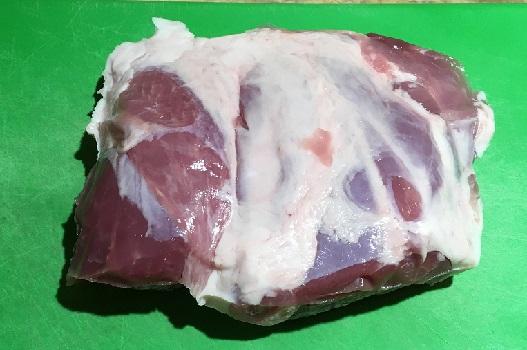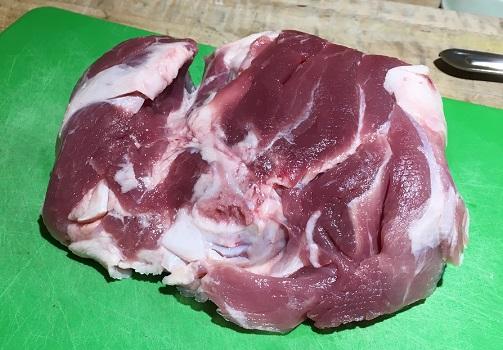Search the Community
Showing results for tags 'Modernist'.
-
Im wondering if anyone here as tried to age a steak w fish sauce. consider : using fish sauce to age steaks if this doesn't give you an interesting list , just type in the above w Google. I finally go around to trying this w RedBoat40 and a thick sirloin strip. then SV my results are here : note the ModernistCuisine method in one of the first links 3 days sealed , 3 days cheesecloth , conventional cooking. I only did my steak one day in the RB40 , then SV if you like ' aged ' tasted , try some sort of variation. if you have tried this : how long did you leave the steak w the sauce in the refrigerator ? next time Ill add a little more RB40 initially and leave it for three days. Im unlikely to try the cheesecloth additional time. has anyone done this ? I might even try it on bland flavorless skinless boneless CkBr's
-
Wonder if someone could get me in the ballpark..the amount of Transglutamase...to make scallop noodles.. % I mean ill use a food processor..to purée the scallop.. then inject into a water or broth..to cook?
-
Hi, I've tried to make the spherical mussels recipe from the Modernist Cuisine books and it didn't work as I expected, so I would appreciate any advice that may help here. The recipe calls for calcium gluconate which I couldn't get hold of, so I replaced it with calcium lactate gluconate that I had at home. I used the same ration (2.5%) When I tried to create the spheres in the sodium alginate bath I encountered two main problems; 1. instead of spheres the mixture just stayed as uneven shape on the surface. The bath was 1Kg. water with 5gr. sodium alginate and I let it rest in the fridge for 24 hours before using it so I think the problem is not here. However, the mussels jus mixture (100gr. mussels jus, 0.5gr. xanthin gum and and 2.5gr. calcium lactate gluconate) had a lot of air bubbles in it. Can that be the issue? 2. In the book the spheres seem to be completely transparent whereas my mussels jus mixture was pretty white and opaque. Is it because I replaced calcium gluconate with calcium lactate gluconate? Or maybe it's because the jus itself should be clarified before it is used? Thanks in advance for your support, Tom.
-
Good afternoon everyone! I currently own a MiniPack MVS31x chamber style vacuum sealer and am wondering if a Polycience vacuum canister will work in my machine? The intended use is for making a larger batch of aerated mousse.
-
Hello! I was wondering if anyone on here has tried using an induction cooktop with confection making (caramels, fondant, marshmallows ect...). My stove has literally three settings, and the low setting still burns sugar and there is no such thing as maintaining any sort of "simmer". I was looking into getting a cooktop and buying some copper sugar pots and mauviel makes this thing that goes inbetween. I would love to hear any input into this idea or your experiences! ~Sarah
- 2 replies
-
- Chocolate
- Confections
-
(and 3 more)
Tagged with:
-
Hi :-) Bought 1.7Kg pork chunk, might be a bit of weird cutting, seems like a rack of pork chops caught between V shaped in bones. Would like to sous vide it whole without further cutting to single steaks and would be glad to get a direction for temp and time, from what i've seen 60-62C area might be great to keep it juicy but i'm lost with the time, as it is a big chunk and not single steaks.. Thanks !
-
Not sure if this is the correct forum--perhaps "Beverages and Libations" would be more appropriate. I am interested in using aquafaba as a substitute for raw egg whites in a pisco sour. I know how to make it, though I tend to cook my own beans rather than using canned ones. My question is, can aquafaba be frozen and still whip up like an egg white? It doesn't last very long in the fridge, I know, so I'd like to stockpile it a little for future use. I'm cooking garbanzos right now and I know not to pour the liquid down the drain. And if anyone has any tips for using it in other applications please let me know. Nancy in Pátzcuaro
-
Hey all, I've made thicker and creamier sorbets with 25% to 35% sugar strained fruit purees and sugar, syrups, and other stabilizers that have worked well. However, because it's so much fruit and little to no water it can be an expensive project. I am trying to make "Water Ice" or "Italian Ice" in my home ice cream machine. Think of textures similar to Rita's Water Ice, Court Pastry Shop, or Miko's in Chicago. It eats much lighter than a sorbet but isn't really icy, but it's also not thick like sorbet. Ritas uses "flavoring" and sugar, while the other two use fruit juice. I'm thinking of thinning the strained fruit juice with water and adding a stabilizer, but I'm having trouble getting this in my home ice cream machine without it freezing solid like granita. Can anyone suggest a way to use real fruit juice, water, and a combination and concentration of stabilizers to get a looser, frozen fruit dessert that isn't icy?
-
Does anyone have reliable tricks for getting good flavor out of garlic in a sous-vide bag? I'm talking about using it just as an aromatic, while cooking proteins, or as part of a stock or vegetable puree. The one time I forgot the maxim to leave raw garlic out of the bag, I ended up with celeriac puree that tasted like a tire fire. I see some recommendations to just use less, but in my experience the problem wasn't just too much garlic flavor. It was acrid, inedible flavor. Using less works fine for me with other mirepoix veggies. I also see recipes for s.v. garlic confit (listed by both Anova and Nomiku) and for some reason people say these taste good. How can this be? There was a thread questioning the old saw about blanching garlic multiple times in milk, which didn't come to any hard conclusions. I'm wondering if a quick blanch in water before adding to the s.v. bag, to deactivate the enzymes, would do the trick. But I don't know the actual chemistry behind the garlic tire fire, so am not confident this would work. Some cooks advocate garlic powder; I'm hoping to not resort to that. Thoughts?
-
Recently cooked whole bone-in lamb shoulder sous vide for 8 hours @ 80°C. The results were like a typical braise. More interestingly, I weighed the different components after cooking for future reference. Here is the breakdown: Before cooking: 2.1 kg lamb shoulder – whole, bone-in, untrimmed After cooking: 621 g liquid 435 g bones and fat 1044 g meat Almost precisely half of the total weight was meat. Hopefully this will be helpful if you are trying to calculate portions. As an aside to this: we've been cooking our tough cuts (sous vide) whole, without any trimming at all, and removing fat and bones after cooking. It is so much easier and faster than trimming everything beforehand. The excess fat comes off in large pieces and connective tissue peels away cleanly. Lamb shanks, for instance, are tedious to trim before cooking but easily cleaned up after they come out of the bag. It's luxurious to have big, clean pieces of shank meat although some may prefer on-the-bone presentation. We have tried this with pork shoulder, too, and the unwanted fat is easily removed after cooking with lovely hunks of tender meat remaining for slicing, dicing or shredding.
-
Is it possible to put a rub on a sous vide item? I'm cooking pig wings here and I'm trying to figure how to finish them. This looks good but would require a rub.
-
Wikipedia defines pork wings as: a pork product made from the fibula of a pig's shank - a single bone surrounded by lean, tender meat. Images from the internet look like a finger-size bit of meat around a bone. Mine, however, look more like the meat (lots) which surrounds a bone. My butcher called this cut pork wings. You can see on the right that there's a small amount of bone. My butcher said he regularly ate SEVERAL of these. But this one measures 15 oz (425g). He also said it had to be cooked slowly. So, if I cook these sous vide, what temp and for how long?
-
Good morning! Long story short: I am doing a spin off the coconut/chocolate/almond candy (almond joy), and trying to create a specific shape out of the almond. My hands are cramped after a couple dozen failed attempts whittling roasted almonds, so now I'd like to try a different approach, and instead, create some kind of sub-candy or cookie with roasted almonds that I can put into a mold or use a mini cookie cutter. I'm fairly new to sweets, my knowledge in this area is pretty slim. Some ideas so far, I don't like any, but it might help turn some gears: 1. dusting almond over a stencil, but that's not enough almond nor crunchy enough 2. almond brittle, but that's too hard and sweet, I'd like it more of a soft crunch, and bringing the almond flavor forward 3. meringue with almonds (sort of macaron-ish), however, weather has been humid and raining here, and I'm ending up with a gooey mess instead of that soft crunch In addition to having almond-forward taste and soft crunch texture, it'd be fun to explore something modernish - I have a accumulated a few tools and ingredients not customarily found in homes. There are dietary considerations I will have to account for, however, no need to worry about that now, I am just looking for ideas and a place to take it from there Thank you for your time in reading!
- 16 replies
-
- Chocolate
- Confections
-
(and 1 more)
Tagged with:
-
Host's note: this delicious topic is continued from What Are You Cooking Sous Vide Today? (Part 2) Duck breast, 57C for 90 min, pre and post sous-vide sear. So the texture was not significantly different from what I get with my usual technique, which is grilling over charcoal. But it's more uniformly pink, and there are no slightly overdone spots. I am pleased with the results even though searing in the house means a ton of smoke and duck fat everywhere! (I did it on the stove in a cast iron skillet, next time I will place the skillet in the oven)
-
FOOD BRETHREN! I need some advice. I have one last piece of pork belly confit in the fridge. I brined these bad boys for about 5 days (brine included pink curing salt), vacuum sealed the squares of pork belly with lard and sous vide them at 158 F for 16 hours. I cooked this on 11/10/16 and its been in my refrigerator since. Here is the general recipe I followed, with some modifications based on my taste: https://www.chefsteps.com/activities/... The last piece is still vacuum sealed and submerged (mostly) in lard. Any visible pork only has contact with the bag. It's staring at me. And calling my name. I want to deep fry this sucker and have a little date night with the handsome devil I see in the mirror every morning, but the last thing I want is spoiled food. I can't find any conclusive information about how long pork confit lasts for. I've only seen references that duck confit or in general that the confit technique will last for months in the fridge. I have found no sources which directly addresses pork confit. Questions/Factors I'm Considering: - Does pork confit keep for as long as duck confit? - Does vacuum sealing have any effect on the length of preservation? - Does sous-vide cooking method affect the length of preservation? I know I am probably being a bit paranoid, but I thought I would do my due diligence before taking the plunge, so to speak. Any advice on these questions would be extremely helpful and appreciated! The Franzisaurus-Rex PS - you should totally make this if you are into sous vide, confit, food, or have any respect for the enjoyment of life. Flash-searing these things after cooking was OUT OF THIS WORLD.
-
The NY Times has a current article in the science section "A Universe of Bubbles in Every Champagne Bottle". The article asserts that it is better to serve Champagne at warmer than refrigerator temperatures so that the bubbles are larger and convey more flavor. Also to serve in a narrow glass. However Gerard Liger-Belair (who is referenced as an authority in the Times article) points out in his book Uncorked (forward by Herve This) that the colder the wine the more viscous and the more dissolved CO2. Liger-Belair also prefers a goblet to a flute. I bought Uncorked after reading about it in Liquid Intelligence from Dave Arnold. Discuss.
-
I made a Gellan based fluid gel that I think is 'too thick'. (One could say, I'd like more fluid and less gel!) Anyone know what the best way, if any?,there is to thin it so I can squeeze bottle it? at the moment it's spoonable but way thick. Could I add water and blender it again? or is there another idea? thanks in advance.
-
HI guys, I'm here for a bit of advice. We are building a house (in Croatia, Europe), and finally have a chance to build a kitchen as i want it We would like to get a professional combi oven, something like this new Rational (a bit pricey) or this UNOX (better price) so that we have a long term solution for our needs. The reason we are going for the professional oven is that, for example UNOX, is cheaper than "home combi ovens" from brands like Miele, Gaggenau, etc. and are much better than those. Does anyone have any experience with pro combis at home? i have only seen a couple of people, at least on the internet, that have them at home. I guess that setup would not be a problem, because we designed a water inlet and outlet for the oven, and the voltage is OK. is there anything we didnt think of? Will that oven have higher maintananace cost, even if its used only couple of days a week? Thanks for help P
-
Hello, This is my first post here -- apologies if I'm making any mistakes on protocol -- I have spent some time checking prior posts but this seemed the best place to jump in. I have a 13lb skin-on, loin attached pork belly I'm going to cook for Christmas dinner. Coincidentally I also have an Anova sous vide circulation heater and a new plastic tub with a lid. The recipes I've saw mostly call for seasoning, a water bath for 36 hours and then a deep or pan fry to crisp. Now I have the setup, and look at the combination of the roast and the container I realize I have some questions about what I'm doing -- I've attached a picture below of what we're starting off with. Here are those questions: The fit seems a little tight to me -- is the container size fine? I was planning on seasoning, tying and double bagging it in large ziploc bringing bags ( water displacement, no vacuum sealer ). I've convinced myself the ziplock method is fine, but is standing the meat vertically in a space close to it's dimension for a 36 hour cook ok? After the 36 hours in water, it is Ok to refrigerate? The main recipe I've been using as a base calls for removing it, shocking it and then removing the liquids for sauce before deep frying -- would it be ok to shock, refrigerate for several hours, then bring to temperature in the bath again before proceeding with browning/bringing to temp? If this isn't a bad idea, how long would you keep in the water bath after refrigeration? Deep frying vs. a quick hot oven? I'll rub baking soda on this, and I'll fry if need be -- but does anyone have experience or thoughts on whether you'd be defeating the purpose of using sous vide in the first place if you just used a suitably hot oven to crisp the skin after cooking sous vide and drying the skin beforehand? I'd prefer not to to do an inside stove top fry for something this large right before dinner if it wasn't sacrificing too much. Thanks for any help, would also be great to hear any other useful advice from anyone that's went through a similar process. Gary
-
When do you start counting the time in sous vide cooking? - when you first put the plastic bag into the heated water? Or, - when the heated water comes back to the desired temperature? I have a 7 quart slow cooker with an Auber instruments controller. There is nothing to circulate the water, but it has never proved to be a problem for me before. Sous vide fish is a new activity for me. After much research I planned 119F for 20 minutes, though in future I'll try one degree lower each time. My first experiment was salmon tail and it was the most delightful salmon I have ever eaten. Water heated to 119F. Added marinaded fish in a ziplock-type bag which had been removed from the fridge not long before, and I used the sous vide water to push the air out of the ziplock bag. Temp dropped enormously (but I don't recall exactly) and it took 15-20 minutes to get back up to 119F. Then I cooked for 20 further minutes. Second experiment was salmon tail and it was as boring as I usually find salmon. I took the marinaded fish out of the fridge 1 hour or 1 1/2 hour before it went into the sous vide pot. I used lukewarm water in bowl in sink to remove air from ziplock. When the fish was dropped in, the temp dropped to 113F. I was not as anxious watching the temp rise this time, so I didn't check it every few minutes. Somehow the water got up to 124F. In both these cases I used a soup bowl in the sous vide pot to hold the fish under water. So, short of buying some new sous vide equipment, could you advise me about things I could do to minimize the temperature drop and maximize my control over the fish.
-
I usually cook topside beef joints at about 55 degrees for 6 hours, and that gives me a nice even pink and tasty joint. I'm quite interested in trying a very slow cook, like 24 hours maybe, but researching this online, the resulting guidelines just seem to recommend these long cooking times for tougher cuts of meat. Has anyone tried this long a cook on a low heat with joints like topside? Are there any online recommendations for this kind of thing? Thank you kindly
-
This year i decided to take a 22lb turkey and remove the Leg quarters and sous vide @165F for 6 hours. I also removed the turkey crown and sous vide it @ 150F for 4 hours. Both were immediately ice chilled and put into the fridge. The plan is to reheat back in the sous vide @ 135F and right before serving time, deep fry in the turkey fryer for a few minutes to crisp up the skins. I just am just not sure the time needed to bring this pretty large whole deboned (3-4 inch at the thickest spot) turkey breast up to temp. The leg portion is about the same thickness maybe slightly thinner. Given there is 4 hours till serving time, I am wondering what effect 135F would have if left in for 4 hours? I am looking for traditional textures. Relatives will not eat if any hint of pink. Anyway, 1,2,3,4 hours @ 135F from 38F already pre cooked. 3-4 inches thick. thanks
-
I've just cooked two lamb shanks sous vide for 72 hours at 141F in separate bags. When I opened the first bag, the shank looked and smelled great. The second bag, however, smelled bad (to me). The shank was covered in gelatinous red stuff. My husband is less smell-impaired than I, so he ate that one. The two shanks were purchased from the meat market associated with the Department of Animal Sciences at the local university where the students will have butchered the animals. I'm wondering if what's possible is that one of the shanks did not have all the blood drained out. And that the smell which I've associated with "bad" is actually the smell of blood.
-
I want to make mint spheres for use in a hot sauce. (Think lamb with mint caviar.) Can this be done? Is it possible to make heat-stable spheres? What is the most effective way to extract mint flavour from the raw leaves? I don't want the resulting spheres to contain alcohol as it will be served to children. My cursory investigations indicate that glycerol may be an alternative—has anyone done this?
-
I recently did some halibut steaks sous vide. They were about 1 1/2 inches thick. I did them for 30 minutes at 122 degrees. When i took them out to brown them, they were very fragile. As I browned them they fell apart. They were delicious, perfectly cooked from an eating point of view, but ugly. Too hot, too long or both?











